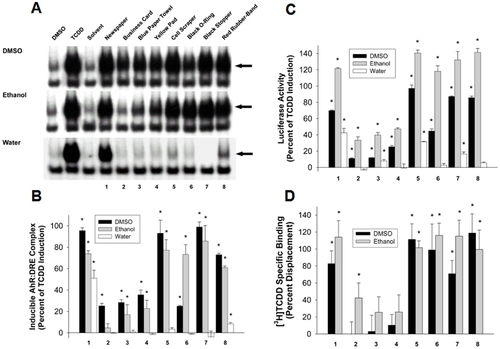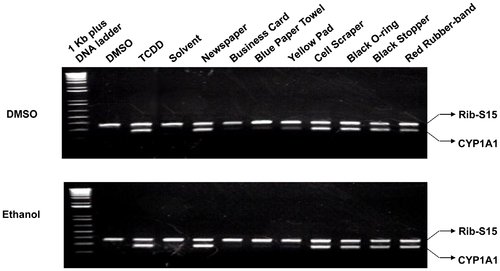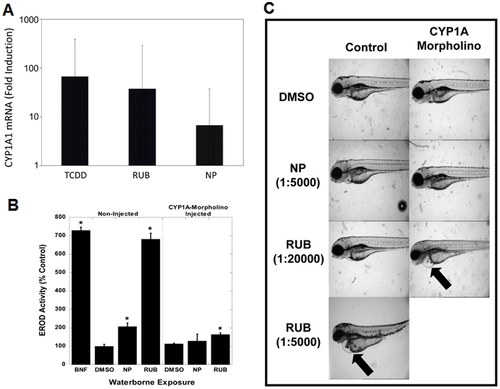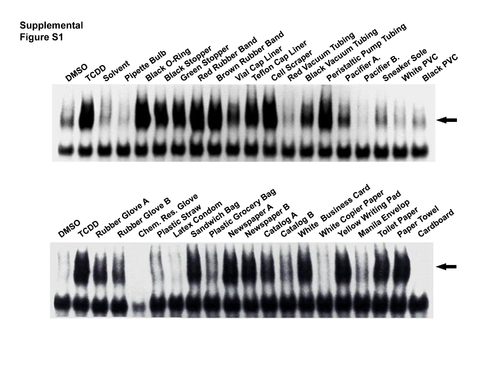- Title
-
Common commercial and consumer products contain activators of the aryl hydrocarbon (dioxin) receptor
- Authors
- Zhao, B., Bohonowych, J.E., Timme-Laragy, A., Jung, D., Affatato, A.A., Rice, R.H., Di Giulio, R.T., and Denison, M.S.
- Source
- Full text @ PLoS One
|
Activation of the AhR and AhR-dependent signal transduction pathway by DMSO, ETOH and water extracts of commercial and consumer products. The products used in these studies were (1) newspaper (black print section only); (2) business card; (3) blue paper towel; (4) yellow pad; (5) cell scraper; (6) black rubber O-ring; (7) black rubber stopper; (8) red rubber-band. (A) Stimulation of AhR transformation and DNA binding by extracts of the indicated commercial and consumer products in vitro. The arrow indicates the position of the ligand-activated protein-DNA (AhR:ARNT:DRE) complex in the gel retardation assay and results are representative of three individual experiments. (B) The amount of ligand-activated protein-DNA complex formation from gel retardation experiments from part A was determined by phosphorimager analysis. Values are expressed as the percentage of maximal TCDD induction and represent the mean ± SD of all DNA binding data compiled from duplicate gels from three individual experiments. Values significantly different from solvent alone (pd0.05 as determined by the students T-test) are indicated by an asterisk. (C) Induction of luciferase activity by individual extract in recombinant guinea pig (G16L1.1c8) cells. Cells were incubated with the indicated extract (10 μl/ml) for 4 h and luciferase activity determined as described in Materials and Methods. Values are expressed as a percentage of the maximal induction by TCDD and represent the mean ± SD of triplicate determinations and those values significantly different from solvent alone (pd0.05 as determined by the students T-test) are indicated by an asterisk. The results shown are representative of three individual experiments. (D) Competitive binding between [3H]TCDD and the indicated DMSO or ethanol extract for the guinea pig hepatic cytosolic AhR. Guinea pig cytosol was incubated with 2 nM [3H]TCDD in the absence or presence of the indicated extract for 2 h at 20°C, and specific binding of [3H]TCDD was determined by hydroxyapatite binding. Values represent the mean ± SD of triplicate determinations and are representative of three individual experiments and those values significantly different from solvent alone (pd0.05 as determined by the students T-test) are indicated by an asterisk. |
|
Effect of extracts of commercial and consumer products on CYP1A1 mRNA levels in mouse hepatoma cells. Hepa1c1c7 cells were incubated with DMSO (10 μl/ml), TCDD (1 nM in DMSO) or the indicated extract (20 μl/ml) for 3.5 hr at 37°C, mRNA was extracted, subjected to RT-PCR and the resulting products were visualized by agarose gel electrophoresis. PCR amplification of CYP1A1 and ribosomal S15 (the loading control) from these samples was carried out as described in Materials and Methods and the results shown are representative of two separate experiments. |
|
Effect of extracts of newspaper and rubber on human skin CYP1A1 mRNA, embryonic zebrafish CYP1A-dependent EROD activity and zebrafish development. (A) Human skin was incubated with the indicated extract (newsprint (NP) or rubber stopper (RUB) at 1% final concentration) overnight at 37°C, mRNA was isolated and transcribed into cDNA and quantitated by real time PCR. Values are expressed as the mean ± SD of 4 (TCDD) or 6 (extract) individual skin samples. All values were significantly different from those of DMSO controls (set to 1) at p<0.05 as determined by one-way ANOVA using Stata/SE9.2 software for Windows with Bonferroni corrections. (B) Newly fertilized zebrafish embryos were exposed for 96 h to DMSO (0.02% v/v), newspaper (NP) extract (1:5,000 dilution), or rubber (RUB) stopper (1:5,000 or 1:20,000 dilution) added to the water and some also injected with 2 pumps of 1× Danio embryo water or embryo water containing 0.15 mM CYP1A-morpholino; additional embryos were exposed to the AhR agonist beta-naphthoflavone (BNF, 1 μg/L) as the positive control for the same period. Hatched larvae were collected and analyzed for EROD activity. EROD values are expressed as the mean ± SE of 5 embryos, where the asterisk indicates those values significantly different from the DMSO control at p<0.05 as determined by Student′s t-test. (C) The hatched larvae treated with extracts as in Figure 5B were examined for deformities by brightfield microscopy. |
|
Stimulation of in vitro AhR transformation and DNA binding of guinea pig hepatic cytosolic AhR by DMSO extracts of commercial and consumer products. The extracts were prepared as described in Material and Methods. The arrow indicates the position of the ligand-activated protein-DNA (AhR:ARNT:DRE) complex in the gel retardation assay and the results shown are representative of three individual experiments. |




